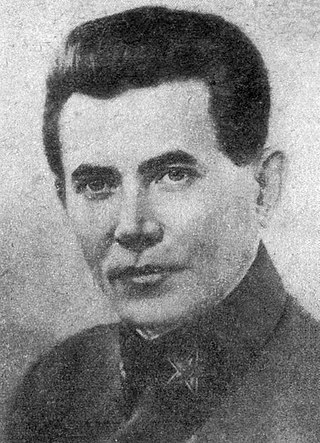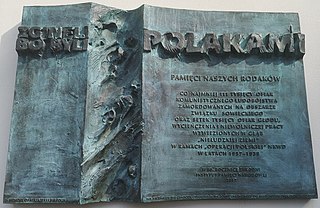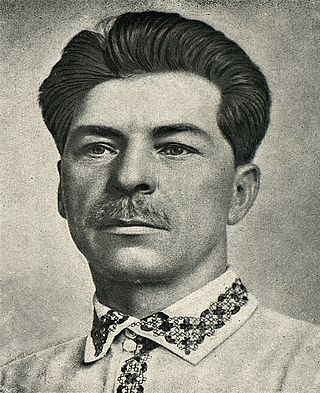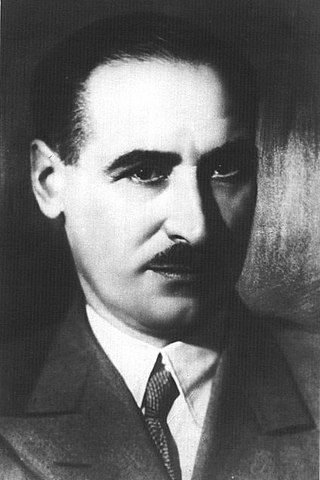Related Research Articles

The Great Purge or the Great Terror, also known as the Year of '37 and the Yezhovshina, was Soviet General Secretary Joseph Stalin's campaign to solidify his power over the Communist Party of the Soviet Union and the state by eliminating his rivals by drastic use of imprisonment and execution. In particular, the purges were designed to remove the remaining influence of Leon Trotsky. They occurred from August 1936 to March 1938, with the most prominent feature being show trials of leading Bolshevik party members. However, a considerable proportion of the country's population was affected as well.

Genrikh Grigoryevich Yagoda was a Soviet secret police official who served as director of the NKVD, the Soviet Union's security and intelligence agency, from 1934 to 1936. Appointed by Joseph Stalin, Yagoda supervised arrests, show trials, and executions of the Old Bolsheviks Lev Kamenev and Grigory Zinoviev, climactic events of the Great Purge. Yagoda also supervised construction of the White Sea–Baltic Canal with Naftaly Frenkel, using penal labor from the gulag system, during which 12,000–25,000 laborers died.

Nikolai Ivanovich Yezhov was a Soviet secret police official under Joseph Stalin who was head of the NKVD from 1936 to 1938, during the height of the Great Purge. Yezhov organized mass arrests, torture and executions during the Great Purge, but he fell from Stalin's favour and was arrested, subsequently admitting in a confession to a range of anti-Soviet activity including "unfounded arrests" during the Purge. He was executed in 1940 along with others who were blamed for the Purge.
NKVD troika or Special troika, in Soviet history, were the People's Commissariat of Internal Affairs made up of three officials who issued sentences to people after simplified, speedy investigations and without a public trial. The three members were judge and jury, though they themselves did not carry out the sentences they dealt. These commissions were employed as instruments of extrajudicial punishment introduced to supplement the Soviet legal system with a means for quick and secret execution or imprisonment. It began as an institution of the Cheka, then later became prominent again in the NKVD, when it was used during the Great Purge to execute many hundreds of thousands of Soviet citizens. Defendants in the Troika's proceeding were typically not entitled to legal aid or the presumption of innocence. Convictions usually did not include information about the actual incriminating evidence and basically contained only information about indictment and sentencing. The outcome of such trials was often determined before it even began due to targeted numbers of citizens to be executed or imprisoned in Gulag prison camps.

The Polish Operation of the NKVD in 1937–1938 was an anti-Polish mass-ethnic cleansing operation of the NKVD carried out in the Soviet Union against Poles during the period of the Great Purge. It was ordered by the Politburo of the Communist Party against so-called "Polish spies" and customarily interpreted by NKVD officials as relating to 'absolutely all Poles'. It resulted in the sentencing of 139,835 people, and summary executions of 111,091 Poles living in or near the Soviet Union. The operation was implemented according to NKVD Order No. 00485 signed by Nikolai Yezhov.

NKVD Order No. 00447 of July 30, 1937 was signed by Nikolai Yezhov and approved by the Politburo during the Great Purge.

The Soviet NKVD Order No. 00485 was an anti-Polish ethnic cleansing campaign issued on August 11, 1937, which laid the foundation for the systematic elimination of the Polish minority in the Soviet Union between 1937 and 1938. The order was called "On the liquidation of Polish sabotage and espionage groups and units of the POW". It is dated August 9, 1937, was issued by the Central Committee Politburo, and signed by Nikolai Yezhov, the People's Commissar for Internal Affairs. The operation was at the center of the national operations of the NKVD, and the largest ethnically motivated shooting action of the Great Terror.
Mass operations of the People's Comissariate of Internal Affairs (NKVD) were carried out during the Great Purge and targeted specific categories of people. As a rule, they were carried out according to the corresponding order of the People's Commissar of Internal Affairs Nikolai Yezhov.
Mikhail Abramovich Trilisser, also known by the pseudonym Moskvin, was a Soviet chief of the Foreign Department of the Cheka and the OGPU. Later, he worked for the NKVD as a covert bureau chief and Comintern leader.

Mikhail Petrovich Frinovsky was a Soviet secret police official who served as a deputy head of the NKVD under Nikolai Yezhov during the Great Purge.

Yakov Saulovich Agranov was the first chief of the Soviet Main Directorate of State Security and a deputy of NKVD chief Genrikh Yagoda. He is known as one of main organizers of Soviet political repressions and Stalinist show trials in the 1920s and 1930s. He fabricated the "Tagantsev conspiracy" case and the Moscow trials, including the Trial of the Twenty One and the Industrial Party Trial, as well as mass arrests and executions in Saint Petersburg during Joseph Stalin's Great Purge.

Pavel Petrovich Postyshev was a Soviet politician, state and Communist Party official and party publicist. He was a member of Joseph Stalin's inner circle, before falling victim to the Great Purge. In 2010, a court in Kyiv judged Postyshev guilty of complicity in genocide because of his part in causing the mass starvation in Ukraine in the early 1930s, known as the Holodomor.
The Stalinist repressions in Mongolia was an 18-month period of heightened political violence and persecution in the Mongolian People's Republic between 1937 and 1939. The repressions were an extension of the Stalinist purges unfolding across the Soviet Union around the same time. Soviet NKVD advisors, under the nominal direction of Mongolia's de facto leader Khorloogiin Choibalsan, persecuted thousands of individuals and organizations perceived as threats to the Mongolian revolution and the growing Soviet influence in the country. As in the Soviet Union, methods of repression included torture, show trials, executions, and imprisonment in remote forced labor camps, often in Soviet gulags. Estimates differ, but anywhere between 20,000 and 35,000 "enemies of the revolution" were executed, a figure representing three to five percent of Mongolia's total population at the time. Victims included those accused of espousing Tibetan Buddhism, pan-Mongolist nationalism, and pro-Japanese sentiment. Buddhist clergy, aristocrats, intelligentsia, political dissidents, and ethnic Buryats and Kazakhs suffered the greatest losses.

Joseph Stalin started his career as a radical student, becoming an influential member and eventually the leader of the Bolshevik faction of the Russian Social Democratic Labour Party. He served as the General Secretary of the Central Committee of the Communist Party of the Soviet Union from 1922 until his death in 1953.
The Moscow trials were a series of show trials held by the Soviet Union between 1936 and 1938 at the instigation of Joseph Stalin. They were nominally directed against "Trotskyists" and members of the "Right Opposition" of the Communist Party of the Soviet Union.
- The "Case of the Trotskyite–Zinovievite Terrorist Center" ;
- The "Case of the Anti-Soviet Trotskyist Center" ; and
- The "Case of the Anti-Soviet 'Bloc of Rightists and Trotskyites'".

The People's Commissariat for Internal Affairs, abbreviated NKVD, was the interior ministry of the Soviet Union.

Yefim Georgievich Yevdokimov was a Soviet politician and member of the Cheka and OGPU. He was a key figure in the Red Terror, the Great Purge and dekulakization that saw millions of people executed and deported.

Robert Indrikovich Eikhe was a Latvian Bolshevik and Soviet politician who was the provincial head of the Communist Party of the Soviet Union in Siberia during the collectivization of agriculture, until his arrest during the Great Purge.

About the anti-Soviet elements also known as Decision of the Politbureau of the CC of the VKP(b) No. P51/94 was a provision of the Political Bureau of the Central Committee of the Communist Party of the Soviet Union of 2 July 1937 that initiated the Great Purge.
Mark Isaevich Gai was a Soviet security and police officer, who played a major part in preparing the Great Purge, during the early stages of which he was arrested and executed.